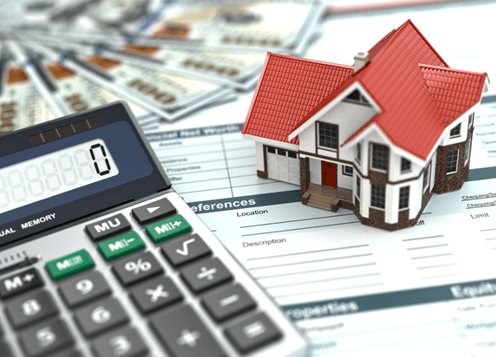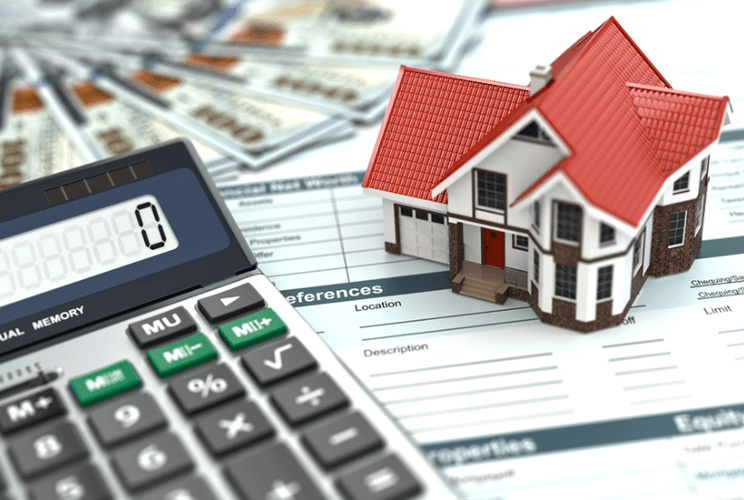Overview: Cost to Build a Home
So you’re thinking of building a home. That’s a lot to think about! Whether it’s the average cost to build a home, or comparing the cost to build a home vs. buying, it can be overwhelming to put together workable numbers. While the task is daunting, getting an estimated cost of building a house doesn’t have to be a nightmare. There are great tools at your disposal, some of which you can find in this article, to get a clearer idea of the cost of building your own home.
According to Home Advisor, the national average cost to build a home in 2016 is $299,947. Since it is a national average, there will be some variance from your own numbers. The average costs depend on a number of factors, such as location. Because fluctuation is likely, it can be helpful to see a price range.
We turn again to Home Advisor, which puts the average cost to build a home between $179,649 and $451,157. This range serves as a better representation of what you can expect to pay. To start clearing these muddy waters, let’s look to some of the variables. Here are some factors that can affect the cost of building your own home:
- Size of the house you want to build
- Number of exterior corners/shape of the house
- Number of stories
- Roofing material
- Cost of the land
- Custom design features
- Finishes and fixtures
- Appliances
You can see why coming up with a personalized estimated cost of building a house is advantageous. Time to unpack this list to see how some of these elements can affect total cost.



Image Source: Cost to Build a Home
See Also: Imortgage Reviews – What You Should Know (Complaints & Review)
Size, Shape, Stories
It’s worth lumping these three elements together because they’re all interconnected. Size is an obvious one. The more you increase the square footage, the more your increase the cost of building your own home.
It’s the same thing with shape, corners in particular. The estimated cost of building a house increases as corners increase. A four-cornered home is less expensive than a six-corner home (think “L”-shaped) and eight corners are more expensive than six, etc.
What about the number of stories in a house? This element is actually the reverse of the first two. The more stories you have (at least when deciding between 1- and 2-story plans) the less expensive it is. This inverse relationship assumes the square footage is staying the same. It makes sense if you think about it: a 1-story home is twice the foundation and twice the roofing of a 2-story home with the same total square footage. And when foundation and flooring increase, so does cost per square foot.
It’s easy to see how states or townships with height-limiting ordinances can skew the prices of building. That’s just one of many reasons why the national average cost to build a home can only serve as a loose, preliminary figure to work from.
The good news here is that if you compare the cost to build a house versus the cost to buy a house in regard to shape, size, and number of stories, the price trends are similarly scaled.
Don’t Miss: Types of Home Loans – What You Should Know (Different Types & House Loans)
All-in-One Change Management Tools
Top Rated Toolkit for Change Managers.
Get Your Change Management Tool Today...
The Less Apparent Costs
It’s easy to forget things. Building a home is no small undertaking (even small homes, which we’ll get to in a bit!), so it’s a good idea to familiarize yourself with everything that could increase the cost of building your own home. These less apparent factors of the design and construction processes will help you craft a more realistic estimated cost of building a house.
For example, there are a lot of roofing options, each with various costs:
- Asphalt/composition shingles: $2-$4 per square foot
- Wood shingles: $5-$12 per square foot
- Metal panels and tiles: $3.50-$11 per square foot
- Clay or concrete tiles: $5.50-$10.50 per square foot
- Slate: $10-$20 per square foot
There’s not enough room in this article to cover the complete scope of roofing choices, so check out this handy roofing materials guide over at House Logic for even more information.
Then there are the even less obvious costs, like these:
- Permits and utilities
- Land preparation
- Constructions costs
Make sure to ask your architect or builder if these potential fees are included or if you are responsible for fielding these additional costs. It’s these hidden costs that can really increase the cost of building a house compared to buying a house. Being aware of these potential charges is a great step toward keeping building costs reasonable.
Pay the same kind of attention to land preparation. Make sure that any land preparation charges are included. If they are not included, you know to budget for them.
And finally, construction costs are the same way. As the physical house is being built, the workers will need certain things. These could include (but are not limited to):
- Portable bathrooms
- Fence rental for the property’s perimeter
- Material and waste disposal
The company you’re working with may have built these into the charges, but if you want to keep your estimated cost to build a house accurate, you’re going to need to make sure everything is accounted for. Bottom line? Go over the pricing with your architect or builder and make sure everything is covered.
Related: Best Banks for Mortgages – A Complete Guide (Best Mortgage Rates & Reviews)



But Who Will Help Me Build This House?
Let’s go back a step. When it comes to designing the size and shape of your house, you’re going to need professional help. You basically have two options:
- Architects
- Homebuilders
Typically, architects will be more expensive. The price disparity isn’t always as great as you might think. So how do you know if the architect option is for you?
The more unique the vision for your home, the more likely it is that you’ll require an architect. Architects can offer creative design solutions and customization well beyond the capabilities of builders and developers. If you’re looking for a one-of-a-kind house or have a special goal (like a green home), an architect is most likely the better choice.
Homebuilders are a great option if you only need a little customization at a slightly better price. They usually have tens, if not hundreds, of home design plans to pick from. While you’ll have a house that’s similar to others out there, you’ll still get the option to tweak it. This could be a change as simple as a countertop finish to something as substantial as switching the locations of different rooms in the house. Another benefit to using the builder is the potential for faster construction time.



Image Source: Cost of Building Your Own Home
Are Those Your Only Options?
There’s also the option of buying a new home where a new development is going up. Your customization options for this will be reduced, but so will the cost of building your own home. If you want a brand new home at a good price, with a little bit of customization, this is not a bad option to consider. This choice makes even more sense if you’re not tied to a particular plot of land or location, as that element will be dictated by the location of the development.
There are also modular home options, which can help reduce the cost of building a house versus buying a house. Modular homes are built in factories and shipped to your plot. What you don’t save in cost, you’ll save in time. Home Advisor notes that it takes about half of the time to build a house off-site in a controlled factory setting. No weather delays and simultaneous construction onsite and on the house in-factory means you can move into your home in weeks, not months.
Popular Article: SunTrust Mortgage Reviews – What You Should Know (Complaints, Loan & Mortgage Review)









Small House, Big Convenience
With our $299,941 average, a 2,000 sq. ft. home would cost about $150 per sq. ft. on average. How does this price stand up to the new trend of building small houses? What is the cost of building a small house? The Small House Society puts the national average at $125 per square foot, but with either average, the price can change substantially.
As with a larger home, price is largely dependent on a number of factors and tradeoffs, one of the biggest factors affecting the cost of building a small house is quality of material. The density of materials within a smaller home can create a noticeable increase in price per square foot. You could use cheaper materials, but the downside is obviously inferior quality. On the other hand, the overall amount of materials (roofing, foundation, siding, etc.) scales down with a smaller home.
There’s another way to cut the costs of building a small house: DIY. Building small homes without the help of builders is becoming more popular, and because of the popularity it’s become slightly easier to find ways to do it yourself. The downside here, as Small House Society mentions, is the time it could take inexperienced homebuilders to build their own homes. You have to consider that, even if you aren’t paying yourself to build your own home, it’ll take time that you can’t spend doing other things—such as earning money. This could be a rewarding project if it’s something that really interests you.
Closing Time
Before you build your home, large or small, there’s another element differentiating the cost to build a house vs. buying a house. It is the closing costs.
Closing costs are the fees involved in finalizing, or “closing,” a real estate transaction. Typical closing costs for buyers tend to run between 2.5% to 5% of the total home cost.
Here’s a closing cost calculator from Smart Asset, which will be helpful in more accurately approximating your closing costs. There are other tools, too: Bank Rate offers a breakdown of average closing costs by state. Or, if you’d rather look at a map, you can find that here. These are some fees you can expect to show up in closing costs:
- Attorney’s fees
- Inspection fees
- Origination fees (resulting from loans)
- Appraisal fees
- Property line/property surveyor fees
- Title insurance and title background check fees
- Pest inspection fees
- Escrow deposit
- Recording fees
- Underwriting fees
It’s a long list, and not necessarily comprehensive. Different fees will be added or subtracted based on location and other elements in the buying process. It’s worthwhile to go through all the charges line by line with your lender to make sure you aren’t getting charged for unnecessary things. It’s worth noting that there is a little bit of room for negotiation with closing costs.
When building a new home, closing costs can be very expensive. Instead of being split by the buyer and the seller, they all go to you. Since you are solely responsible for the closing costs, the cost to build a house vs. buying a house tips out of favor. But there’s hope. You will receive a Good Faith Estimate, or a GFE, from your lender within a few days of your application’s acceptance. Shopping around different lenders is a perfectly viable option.
And there’s more good news. According to an interview at New Home Source with realtor Joanne Stucky, builders will offer incentives, commonly between 2 and 3%. Usually there’s a caveat that you use the builder’s preferred lender.
Read More: How to Get a Home Equity Loan with Bad Credit (What You Need to Know)
Free Wealth & Finance Software - Get Yours Now ►
So How Much Does it Cost?
It turns out there’s no official answer. At least, not without specifics. Use tools like the closing cost calculator and others found on Bank Rate to find the best lenders and best locations to build your home.
Even though the typical closing costs for buyers building new homes can be higher, there are incentives offered by the builders to offset these costs.
There are more options than you ever knew for home decor and materials, so take your time with it. Sort out your needs and your wants.
Eliminate the possibility for hidden fees and additional charges by reviewing the pricing plans and bills carefully, line by line.With careful planning, your estimated cost of building a house can be your actual cost of building a house.
AdvisoryHQ (AHQ) Disclaimer:
Reasonable efforts have been made by AdvisoryHQ to present accurate information, however all info is presented without warranty. Review AdvisoryHQ’s Terms for details. Also review each firm’s site for the most updated data, rates and info.
Note: Firms and products, including the one(s) reviewed above, may be AdvisoryHQ's affiliates. Click to view AdvisoryHQ's advertiser disclosures.





